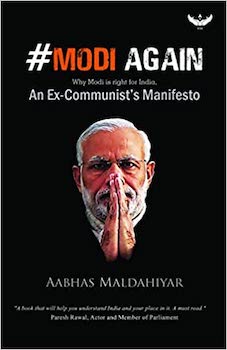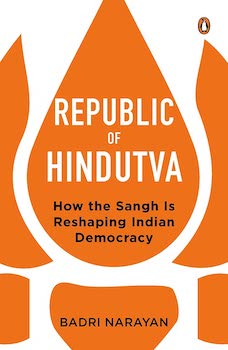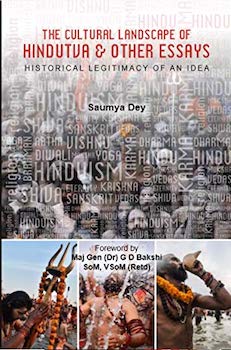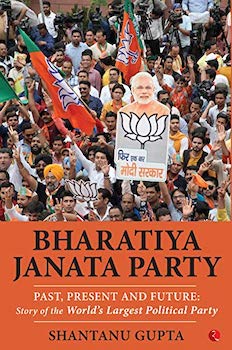Books We Are Reading
 #MODI AGAIN (Why Modi is right for India) An Ex-Communist’s Manifesto
#MODI AGAIN (Why Modi is right for India) An Ex-Communist’s Manifesto
Aabhas, a self-professed Marxist voted against BJP and Narendra Modi in 2014. This is the story of his journey of transformation from a Modi hater to a Modi supporter.
In his own words— “I had both hearts at twenty and now have brain while I kiss thirty. This is a true story of the journey from being a ‘Marxist’ to an alleged ‘Modi Bhakt.’ I once saw Arvind Kejriwal as the savior of the realm and Modi as a mass-murderer.”
A study tour to Ajanta Caves began to shape a new Aabhas. He questioned the indoctrination into Communist ideology he got in college. “India leaped to become the third-fastest growing economy and its respect in the world reflects on the leadership of Modi. This is a New India, making alliances and friends, and willing to hit its enemies hard.
Bhartiya Janata Party: Past, Present and Future: Story of the World’s Largest Political Party (BJP) Kindle Edition by Shantanu Gupta
On 29th March, 2015, at BJP’s old office at 11, Ashoka Road, a digital counter was ticking. Party workers, office bearers and even staff, all were staring at the digital screen. The screen was showing the total number of party members enrolled through the party’s new ‘Sadasyata Abhiyan’ (Membership Drive). The party’s national president Amit Shah was in office that day. With a childlike eagerness in his eyes, he too was looking at the digital counter. As soon as the counter hit the target, the whole office erupted in euphoria. It reached 8.8 crore members, surpassing the Communist Party of China. The ambitious membership drive was Shah’s idea. Next day every leading newspaper reported it bold and clear—BJP becomes the largest political party in the world.
How did this happen? Was it merely a numerical exercise which boosted Bharatiya Janata Party’s fortunes or was it the case of an idea whose time had come? From a mere two seats in the Lok Sabha in 1984 to now having decimated the opposition, can this juggernaut be attributed to only the Modi-Shah duo or the reasons run deep into the complexity of the highly misunderstood Hindutva movement? To answer these questions, Shantanu Gupta travels back into the history of the Right-wing movements in India, from their ideological origins to the evolution of their nationalist idea, bringing together a comprehensive study of not just BJP as a political party but of an ideological entity which defines the nationalist movement in the country like never before.
 Republic of Hindutva: How the Sangh Is Reshaping Indian Democracy by Badri Narayan
Republic of Hindutva: How the Sangh Is Reshaping Indian Democracy by Badri Narayan
For many years, the Rashtriya Swayamsevak Sangh has been working towards social reconstruction in India, which is then used by the Bharatiya Janata Party for political benefit. Contrary to popular understanding, the RSS has transformed to become more technologically savvy and socially inclusive, making the message of Hindu nationalism appealing to a large section of Indians. It has been actively mobilizing Dalits, tribals and other marginalized communities to assimilate them into the Hindutva metanarrative. Instead of wiping out caste from electoral politics, the RSS plays up the identity of disadvantaged groups, which translates into votes for the BJP. Drawing on extensive field research in the heartland of Uttar Pradesh, this pathbreaking book shows how through well-planned strategies of appropriation and social work, Hindutva forces are radically reshaping Indian democracy
 The Cultural Landscape of Hindutva & Other Essays: Historical Legitimacy of an Idea by Saumya Dey, Maj Gen (dr) G D Bakshi (Foreword)
The Cultural Landscape of Hindutva & Other Essays: Historical Legitimacy of an Idea by Saumya Dey, Maj Gen (dr) G D Bakshi (Foreword)
‘The Cultural Landscape of Hindutva: Historical Legitimacy of an Idea’, the title piece of this volume, seeks to establish that Hindutva is no artificial contrivance but an ethical concatenation of Dharma, dharā and rajya rooted in the Indic civilisational ethos and representative of a cultural landscape, or lifeworld. It is followed by eleven more essays pertaining to various political, cultural and historical themes. Like the title piece, they all are attempts at ‘counter-narrativity’. Citing facts, evidence and drawing upon academic works, they seek to provide the reader an alternative to the standard, disingenuous ‘left-liberal’ narratives that dominate Indian media and academia

























